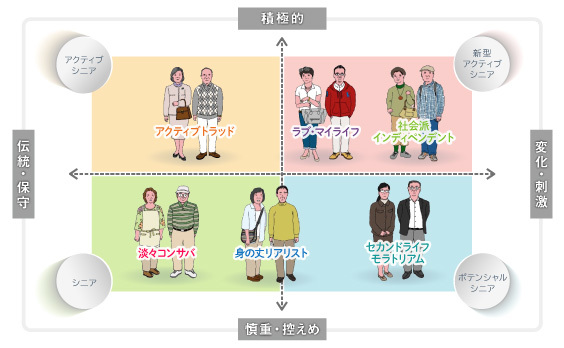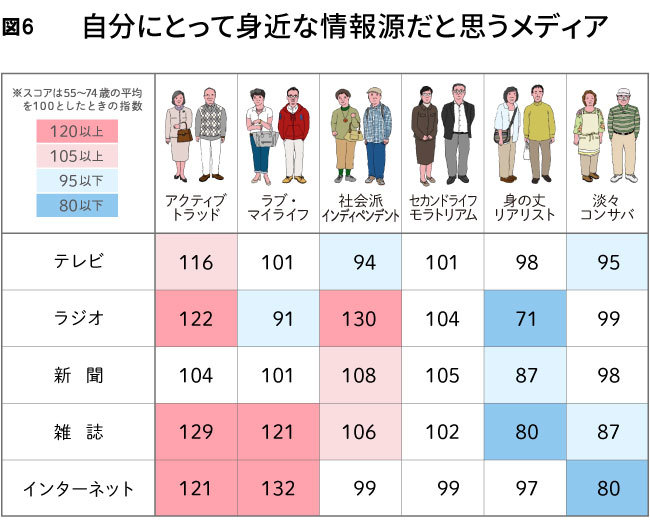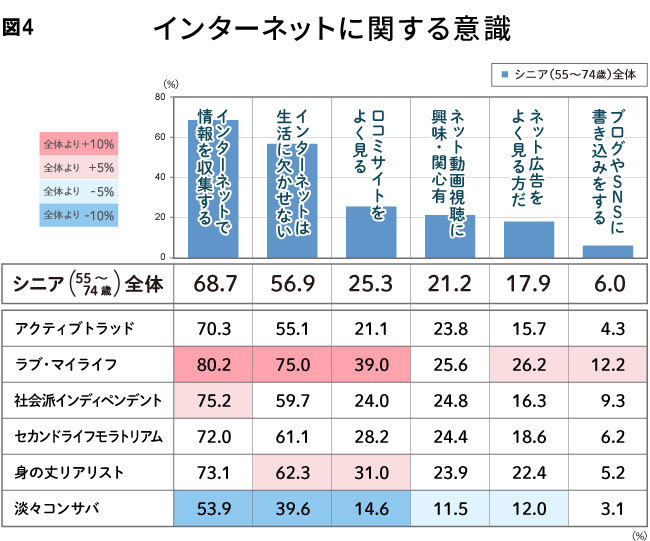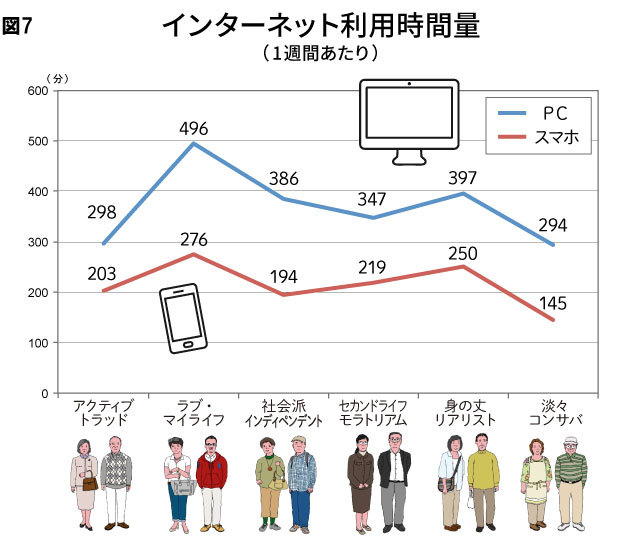Last time, we introduced differences in "shopping" awareness as an example of how values vary.
This second installment examines differences in attitudes and behaviors regarding digital environments and devices like the internet and smartphones (hereafter "smartphones") based on the latest data from Video Research Ltd.'s "Senior+/ex"※.
Recently, digital technology has rapidly permeated daily life, and it's becoming increasingly common for seniors to use not only PCs but also smartphones. However, compared to younger generations, there is still significant individual variation in seniors' relationship with digital technology. Some aspects of this variation can be understood through their value type.
The "Senior Value Segmentation" is... A new approach to understanding the diverse and complex thinking and behaviors of the senior demographic, segmented by "values." Values are categorized into six types, each plotted on a two-axis, four-quadrant model based on "whether behavior is proactive or reserved" and "whether orientation leans traditional/conservative or prefers change and stimulation."

Active Trad: Primarily consists of retirees living comfortably with ample time and money. They are proactive in consumption and activities but hold strong traditional family values. This segment most closely matches the image traditionally associated with "active seniors."
Love My Life: Strong pursuit of youth and beauty, anti-aging awareness, fond of new things, well-informed, and sensitive to trends. One of the "new type" active seniors.
Socially Conscious Independents: Value human connections, are eager to build new networks and engage in intergenerational exchange. Another pattern of the "new type of active seniors."
Unassuming Conservative: Fully satisfied with their current life, desiring nothing more. They hold no strong opinions and live each day calmly and peacefully. Closest to the traditional image of "elderly people."
Down-to-Earth Realist: Often expresses resignation, saying they don't have money or that something is too expensive to do. They aren't necessarily poor, but their consumption is passive, perhaps due to future anxieties.
Second Life Moratorium: They feel strongly about not wanting to be left behind by society and desire connections with people and society. However, they don't know how to achieve this and are searching for how to spend the rest of their lives.
Smartphones spreading among seniors
Smartphone ownership rates among younger generations have already surpassed 90%, reaching saturation. Seniors, however, still show room for growth. Tablets are also gradually increasing in popularity due to their ease of viewing and user-friendly operation. (Figure 1)
Furthermore, we found that voice search functionality on smartphones is used more frequently by seniors than by younger people (Figure 2).
Many seniors complain about the difficulty of input operations on mobile devices due to declining physical abilities, such as presbyopia and slower finger movements. It is thought that voice operation compensates for these age-related limitations.
Since last year, AI speakers have been continuously entering the Japanese market. Several services utilizing their functions, such as monitoring services, have already been realized. If AI improves its learning capabilities to enable natural conversations like those between ordinary humans, it has significant potential to transform seniors' daily activities, such as shopping and accessing information.
Looking at smartphone and feature phone (so-called "galapagos phones") ownership rates by value segment, smartphones outnumbered feature phones in five out of six segments. The remaining segment is the most conservative, the Unfazed Conservatives. Even among this type, ownership rates are nearly equal. Tracking the trend shows that among the Love My Life segment, the reversal from feature phone to smartphone users occurred around 2016, while for the other segments, it happened around 2017. Even among the most conservative Unfazed Conservatives, smartphone owners may soon become the majority (Figure 3).
Love My Life and Down-to-Earth Realist types who can't live without the internet, and the Unfazed Conservative type with low internet awareness
While smartphones are becoming widespread among all seniors as owned devices, what about their sensitivity and affinity toward digital information?
Looking at seniors overall, about 70% gather information online, and over half consider it a daily necessity. (Figure 4)
Among the Love My Life and Socially Conscious Independent groups, who particularly use the internet for information gathering, three out of four Love My Life seniors consider "the internet indispensable to daily life." They also show high usage rates of SNS like LINE and Facebook, indicating strong affinity with the internet overall. In contrast, Socially Conscious Independents do not exhibit such a high level of dependence on the internet. While many use SNS as communication tools, for them the internet remains just one information source among others. They also gather information widely from other media like newspapers and radio (Figures 5 and 6).


Furthermore, among those who frequently shop online, the "Live Within Your Means Realists" ranked second only to the "Love My Life" group in both the proportion who consider the internet indispensable and the amount of time spent online (Figure 7). They also frequently check product reviews and view online advertisements, revealing a pattern of heavy internet use primarily for shopping.
On the other hand, the group with the lowest overall awareness of the internet was, unsurprisingly, the most conservative group, the Unfazed Conservatives.
The Calm Conservatives segment has a slightly older age composition compared to other segments, and this influence is likely somewhat reflected in their results. While digital awareness and affinity can certainly be interpreted as influenced by age effects, it's also true that differences based on individual experience and values play a significant role.
Even as smartphones become more widespread, seniors who fully utilize them remain a minority. However, opportunities to naturally encounter digital technology in daily life are expected to increase through AI, IoT, and similar advancements.
By understanding insights and needs unique to seniors, there remain ample business opportunities in the digital realm—such as developing and providing content, interfaces, apps, and follow-up service menus tailored to each senior.
For inquiries, please contact us here.
hitoken@videor.co.jp
※About "Senior+/ex"
An age-expanded version of Video Research Ltd.'s large-scale single-source data "ACR/ex".
Survey period: April–June 2017 Tokyo 50km radius Ages 55–74, both genders N=1611
Survey Method: Randomly selected households based on population composition were visited to request survey participation.
Responses were collected via electronic survey forms (using loaned dedicated tablet devices).
Video Research Ltd. Human Research Institute "VR Aging Lab"
Video Research Ltd.'s think tank, the Human Research Institute, established a senior research team to revitalize the senior market. To capture the reality of seniors and apply it to marketing activities, the team conducts research, disseminates information, and provides consulting services to companies on senior marketing.
Hito Research Institute:
http://www.videor.co.jp/hitoken/#anc2












